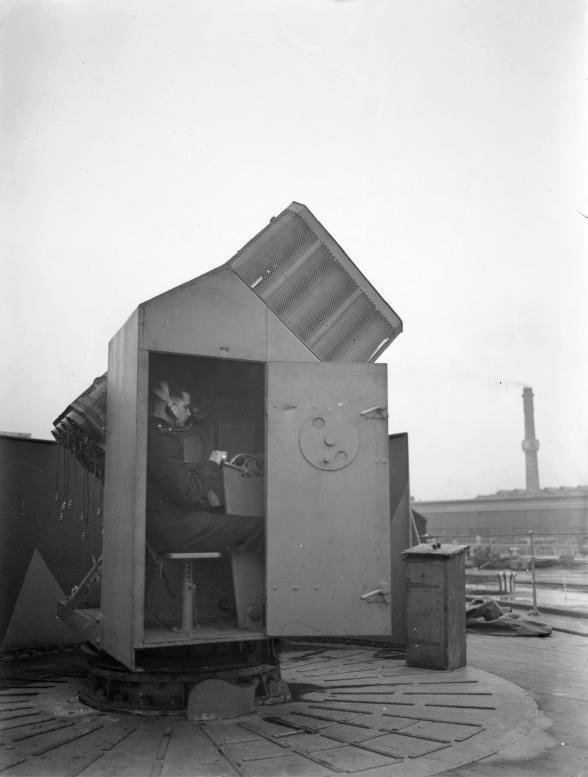 | ||
The 7-inch unrotated projectile, or UP, was a short range anti-aircraft rocket, developed for the Royal Navy. It was used extensively by British ships during the early days of the Second World War, but proved unreliable and ineffective in operation, prompting the withdrawal of the system during 1941.
Contents
Operation
The name "unrotated projectile" comes from the fact that the projectile was not spin-stabilized. The weapon had 20 smoothbore tubes, fired ten at a time. A small cordite charge was used to ignite a rocket motor which propelled the fin-stabilized 7-inch (18 cm) diameter rocket out of the tube to a distance of about 1,000 feet (300 m), where it exploded and released an 8.4 ounces (240 g) mine attached to three parachutes by 400 feet (120 m) of wire. The idea was that an aeroplane hitting the wire would draw the mine towards itself where it would detonate.
Development
The UP was developed by Sir Alwyn Crow who was the director of the Projectile Development Establishment at Fort Halstead. In November 1939, Winston Churchill as First Lord of the Admiralty asked Dr. Crow to produce urgently a means of laying an aerial minefield and to consider other methods of protecting ships against aircraft. It is likely that Churchill was influenced in his request by his friend and advisor Frederick Lindemann who had previously advocated a scheme for "dropping bombs hanging by wires in the path of attacking aircraft". A high-altitude barrage was developed: an aerial minefield up to 19,000 feet (5,800 m), the fast aerial mine up to 2,000 feet (610 m), the PE fuse up to 18,000 feet (5,500 m) and the UP up to 20,000 feet (6,100 m).
The 7-inch UP was developed simultaneously with the 2-inch and 3-inch UP systems, the latter being successfully deployed in the anti-aircraft Z Batteries which were operated by the Home Guard and was the basis of the RP-3 air-to-surface rocket and the Mattress surface-to-surface multiple rocket launcher.
Effectiveness
The weapon was not very effective as it was slow to load and aircraft could avoid the wires. It was replaced later in the war by the 2 pounder or Bofors 40 mm gun.
A demonstration of the weapon for Churchill on Admiral Jack Tovey's flagship at Scapa Flow dramatically exposed a flaw in the concept. Practice bombs were fired and when there was an unexpected change of wind, they drifted back onto the ship and some became entangled in the rigging and superstructure. The dummy rounds caused little or no damage but Tovey was amused at the embarrassment thus caused to the weapon's advocates, Lindeman and Churchill.
The UP ammunition aboard HMS Hood was seen to be on fire just before she exploded and sank in May 1941. The report of the Admiralty Board of Enquiry into the sinking of Hood in September 1941 concluded "That the fire that was seen on Hood's boat deck, and in which UP and/or 4-inch ammunition was certainly involved, was not the cause of her loss", but it noted that "Action has (already) been taken to land UP mountings and ammunition" in the rest of the fleet.
